Adephaga
David R. Maddison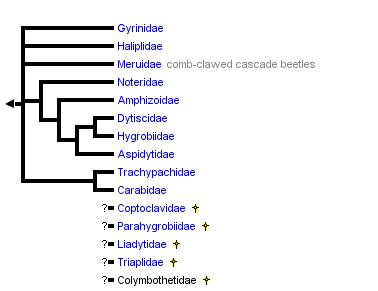


This tree diagram shows the relationships between several groups of organisms.
The root of the current tree connects the organisms featured in this tree to their containing group and the rest of the Tree of Life. The basal branching point in the tree represents the ancestor of the other groups in the tree. This ancestor diversified over time into several descendent subgroups, which are represented as internal nodes and terminal taxa to the right.

You can click on the root to travel down the Tree of Life all the way to the root of all Life, and you can click on the names of descendent subgroups to travel up the Tree of Life all the way to individual species.
For more information on ToL tree formatting, please see Interpreting the Tree or Classification. To learn more about phylogenetic trees, please visit our Phylogenetic Biology pages.
close boxIntroduction
The Adephaga is the second largest suborder of beetles, with over 40,000 known species. Most members are predacious (the Greek word "adephagos" means "gluttonous"). The two living families with terrestrial members, Carabidae and Trachypachidae, are occasionally called the Geadephaga; the remaining, aquatic families are the Hydradephaga. The majority of species in the suborder belong to the family Carabidae.
Adephagans diverged from their sister group in the late Permian, with the most recent common ancestor of living adephagans probably existing in the early Triassic, around 240 million years ago (Ponomarenko, 1977; Erwin, 1979). Both aquatic and terrestrial representatives of the suborder appear in the fossil record in the late Triassic, with a Jurassic fauna consisting of trachypachid, carabid, gyrinid, and haliplid-like forms (Ponomarenko, 1977). The familial and tribal diversification of the group spans the Mesozoic period, with a few tribes radiating explosively in the Tertiary (e.g., members of the carabid subfamily Harpalinae, Erwin, 1985).
Adephagans are diverse in diet and structure. Most are general predators, although algal feeders (Haliplidae), seed feeders (many harpaline carabids), fungal feeders (rhysodines), specialist predators on snails (licinine and cychrine carabids), and ectoparasitoids of other insects (brachinine and lebiine carabids) or millipedes (peleciine carabids), occur. Many lineages have gone down, into caves, while others have gone up, into the rain forest canopy or alpine habitats. The body forms of some have become highly modified structurally for life in unusual habitats (e.g., gyrinids at the air-water interface, paussine carabids in ants' nests, rhysodines in heartwood). Some are ovoviparous (pseudomorphine carabids, Liebherr and Kavanaugh, 1985). A variety of chemical defense mechanisms have evolved in the group, including the explosive discharge of bombardier beetles (Aneschansley et al., 1969).
Characteristics
Members of the suborder have the following properties: Adults with notopleural sutures visible on prothorax, with six visible abdominal sterna, the first three fused and divided by hind coxae; pygidial defense glands; testes tubular, coiled, consisting of a single follicle; ovaries polytrophic. Larvae with fused labrum and no mandibular molae.
Discussion of Phylogenetic Relationships
Family-level relationships within Adephagans have been extensively examined, but no consensus has been reached (for some recent reviews, see Kavanaugh, 1986; Beutel, 1993). There has been detailed examination of head structure (Beutel, 1986, 1989a), thoracic sclerites and musculature (e.g., Bell, 1964, 1966, 1967, 1982; Nichols, 1985; Kavanaugh, 1986; Beutel, 1986, 1988, 1989b, 1990, 1992b) , female abdominal structure (Bils, 1976; Burmeister, 1976, 1980, 1990a, 1990b), ventral nerve cord (Heath and Evans, 1990), digestive system (Yahiro, 1990), wing venation (Ward, 1979), larvae (e.g., Liebherr and Ball, 1990; Bousquet and Smetana, 1991; Beutel, 1991a, 1991b, 1992a, 1992c, 1993; Arndt, 1993), chromosomes (Serrano, 1981b; Serrano and Yadav, 1984), defensive glands (Forsyth, 1972; Kanehisa and Murase, 1977), and defensive secretions (e.g., Kanehisa and Murase, 1977; Moore, 1979; Kanehisa and Kawazu, 1985).
The following three phylogenetic hypotheses give an indication of the controversies surrounding the phylogeny of adephagans. This first tree is from Baehr (1979):
this second from Kavanaugh (1986):
and this tree from Beutel (1995):
Much of the attention has focused on a few controversial groups:
- Trachypachidae: These are considered as either the sister group of Carabidae (e.g., Kavanaugh, 1986), or as the sister group to all or part of Hydradephaga (Bell, 1966; Hammond, 1979; Ward, 1979; Roughley, 1981; Evans, 1982; Arndt, 1993; Deuve, 1993). Bell (1982) believes that "understanding Trachypachus is the key to understanding the Adephaga." Superficially, these terrestrial beetles are very much like carabids, and have frequently been placed in the same family (Lindroth, 1961). However, trachypachids have glabrous antennae, immobilized hind coxae, and medial binding patches on their wings, and in this way are like dytiscimorph water beetles. If the adephagan ancestor was aquatic or semi-aquatic, then trachypachids may represent an intermediate stage, with several morphological remnants (e.g., glabrous antennae) of an aquatic life (Kavanaugh, 1986; Ponomarenko, 1977). According to this view, later lineages lost other indications of an aquatic ancestry, and diversified into modern carabids. In contrast, if the adephagan ancestor was terrestrial, then features linking trachypachids and dytiscimorphs are derived, indicating a close relationship (Roughley, 1981; Bell, 1982).
- Omophronini: This tribe is generally thought to be within Carabidae (many authors including Baehr, 1979; Beutel, 1993; Erwin, 1985), but has been proposed to be related to Hydradephaga and trachypachids (Nichols, 1985; Ruhnau, 1986; Deuve, 1993).
- Cicindelitae (tiger beetles, here included within Carabidae): These may be a separate clade from carabids (Bils, 1976; Regenfuss, 1975), or they may belong within Carabidae, related to carabines (Deuve, 1993; Kavanaugh pers. comm.), hiletines (Ward, 1979), or loricerines (Arndt, 1993).
- Rhysodini: Wrinkled bark beetles may be highly derived carabids, related to scaritines (Bell, 1967; Forsyth, 1972; Beutel, 1990, 1992a) or psydrites (Erwin, 1985) or they may lie outside of carabids (Arndt, 1993; Deuve, 1988; Beutel, 1993). In the Tree of Life project they are placed within carabids.
The critical questions about phylogeny of adephagan families revolve around the placement of the root of the adephagan clade, and the nature of the ancestor. Was the ancestral adephagan aquatic or terrestrial? Is the root next to Gyrinidae (Beutel and Roughley, 1994)? Is the root within terrestrial carabids, with hydradephagans arising within Carabidae (Bils, 1976; Nichols, 1985)? The long independent history of the other suborders of beetles has obscured morphological clues, making the information from outgroups suspect, and the position of the root questionable. For example, the possible sister group to the adephagans, the suborder Myxophaga (Kukalová-Peck and Lawrence, 1993), consists of minute or small aquatic (hygropetric) or interstitial beetles. The reduction in size and specialized habitat of these beetles might be associated with enough correlated, derived modifications to cast doubt upon use of their structural features in outgroup analysis. Hopefully the molecular sequence data currently being gathered will help clarify these issues.
References
Aneschansley, D. J., T. Eisner, J.M. Widom, and B. Widom. 1969. Biochemistry at 100°C: explosive secretory discharge of bombardier beetles (Brachinus). Science 165: 61-63.
Arndt, E. 1993. Phylogenetische Untersuchungen larvalmorphologischer Merkmale der Carabidae (Insecta: Coleoptera). Stuttgarter Beiträge zur Naturkunde Serie A 488: 1-56.
Arnold'di, L.V., V.V. Zherikhin, L.M. Nikritin, and A.G. Ponomarenko (eds.). 1977. Mezozoiskie Zhestkokrylye. Akademiya Nauk SSSR, Trudy Paleontologicheskogo Instituta, Vol. 161. Nauka Publishers, Moscow.
Arnold'di, L.V., V.V. Zherikhin, L.M. Nikritin, and A.G. Ponomarenko (eds.). 1992. Mesozoic Coleoptera. Smithsonian Institution Libraries, Washington, D.C. (English translation of Arnold'di et al., 1977.)
Baehr, M. 1979. Vergleichende Untersuchungen am Skelett und an der Coxalmuskulatur des Prothorax der Coleoptera, ein Beitrag zur Klärung der phylogenetischen Beziehungen der Adephaga (Coleoptera, Insecta). Zoologica 44(4): 1–76.
Ball, G. E. 1979. Conspectus of carabid classification: history, holomorphology, and higher taxa. In T. L. Erwin, G. E. Ball, D. R. Whitehead and A. L. Halpern (ed.), Carabid Beetles: Their Evolution, Natural History, and Classification. The Hague, Dr. W. Junk bv. pp. 63–111.
Belkaceme, T. 1991. Skeleton and musculature of the head and thorax of Noterus laevis Sturm.: Aspects of the morphology and the phylogeny of the Noteridae (Coleoptera: Adephaga). Stuttgarter Beiträge zur Naturkunde Serie A 0(462): 1-94.
Bell, R. T. 1964. Does Gehringia belong to the Isochaeta? (Coleoptera: Carabidae). The Coleopterists Bulletin 18: 59–61.
Bell, R. T. 1966. Trachypachus and the origin of the Hydradephaga (Coleoptera). The Coleopterists Bulletin 20: 107–112.
Bell, R. T. 1967. Coxal cavities and the classification of the Adephaga (Coleoptera). Annals of the Entomological Society of America 60(1): 101–107.
Bell, R. T. 1982. What is Trachypachus? (Coleoptera: Trachypachidae). The Coleopterists Bulletin 36(4): 590–596.
Beutel, R. 1986. Skeleton and musculature of the head and thorax of Hygrobia tarda (Herbst). Contribution towards the clarification of the phylogenetic relationships of the Hydradephaga (Insecta: Coleoptera). Stuttgarter Beiträge zur Naturkunde Serie A (388): 1-54.
Beutel, R. G. 1988. Studies of the metathorax of the trout-stream beetle, Amphizoa lecontei Matthews (Coleoptera: Amphizoidae): Contribution towards clarification of the systematic position of Amphizoidae. International Journal of Insect Morphology and Embryology 17(1): 63-82.
Beutel, R. G. 1989a. The head of Spanglerogyrus albiventris Folkerts (Coleoptera: Gyrinidae). Contribution towards clarification of the phylogeny of Gyrinidae and Adephaga. Zool. Jb. Anat. 118(4): 431-461.
Beutel, R. G. 1989b. The prothorax of Spanglerogyrus albiventris Folkerts, 1979 (Coleoptera: Gyrinidae) Contribution towards clarification of the phylogeny of Gyrinidae. Entomologica Basiliensia 13: 151-173.
Beutel, R. G. 1990. Metathoracic features of Omoglymmius hamatus and their significance for classification of Rhysodini (Coleoptera: Adephaga). Entomologia Generalis 15(3): 185-201.
Beutel, R. G. 1991a. Internal and external structures of the head of 3-rd instar larvae of Amphizoa lecontei Matthews (Coleoptera: Amphizoidae): A contribution towards the clarification of the systematic position of Amphizoidae. Stuttgarter Beiträge zur Naturkunde Serie A 0(469): 1-24.
Beutel, R. G. 1991b. Larval head structures of Omophron and their implications for the relationships of Omophronini (Coleoptera: Carabidae). Entomologica Scandinavica 22(1): 55-67.
Beutel, R. G. 1992a. Larval head structures of Omoglymmius hamatus and their implications for the relationships of Rhysodidae (Coleoptera: Adephaga). Entomologica Scandinavica 23(2): 169-184.
Beutel, R. G. 1992b. Phylogenetic analysis of thoracic structures of Carabidae (Coleoptera: Adephaga). Zeitschrift für Zoologische Systematik und Evolutionsforschung 30(1): 53-74.
Beutel, R. G. 1992c. Study on the systematic position of Metriini based on characters of the larval head (Coleoptera: Carabidae). Systematic Entomology 17(3): 207-218.
Beutel, R. G. 1993. Phylogenetic analysis of Adephaga (Coleoptera) based on characters of the larval head. Systematic Entomology 18: 127-147.
Beutel, R.G. 1995. The Adephaga (Coleoptera): phylogeny and evolutionary history. Pp. 173-217 in Pakaluk and Slipinski (1995).
Beutel, R. G. and R. E. Roughley. 1994. Phylogenetic analysis of Gyrinidae based on characters of the larval head (Coleoptera: Adephaga). Entomologica scandinavica 24: 459-468.
Beutel, R. G. and S. Ruhnau. 1990. Phylogenetic analysis of the genera of Haliplidae (Coleoptera) based characters of adults. Aquatic Insects 12(1): 1-17.
Bils, W. 1976. Das Abdomende weiblicher, terrestrisch lebender Adephaga (Coleoptera) und seine Bedeutung für die Phylogenie. Zoomorphologie 84(2): 113–193.
Bousquet, Y. and A. Smetana. 1991. The tribe Opisthiini (Coleoptera: Carabidae): Description of the larvae, note on habitat, and brief discussion on its relationships. Journal of the New York Entomological Society 99(1): 104-114.
Bousquet, Y., and A. Larochelle. 1993. Catalogue of the Geadephaga (Coleoptera: Trachypachidae, Rhysodidae, Carabidae including Cicindelini) of America North of Mexico. Memoirs of the Entomological Society of Canada, 167:1-397.
Brandmayr, P. and B. T. Zetto. 1986. Food and feeding behavior of some Licinus species (Coleoptera Carabidae Licinini). Monitore Zoologico Italiano 20(2): 171-182.
Burmeister, E.G. 1976. Die Ovipositor der Hydradephaga (Coleoptera) und seine phylogenetische Bedeutung unter besonderer Berücksichtigung der Dytiscidae. Zoomorphologie 85: 165–257.
Burmeister, E.G. 1980. Funktionsmorphologie und Evolution des Ovipositor der Adephaga (Coleoptera). Verhandlungen der naturwissenschaftlicher Verein, Hamburg (NF) 24(1): 89–184.
Burmeister, E.G. 1990a. On the systematic position of Amphizoidae, emphasizing features of the female genital organs (Insecta: Coleoptera: Adephaga). Quaestiones Entomologicae 26(3): 245-272.
Burmeister, E.G. 1990b. The female genital structures of Spanglerogyrus albiventris Folkerts, 1979: A contribution to the systematic position of the Gyrinidae. Spixiana 13(3): 253-265.
Crowson, R. A. 1981. The Biology of the Coleoptera. London, Academic Press.
Deuve, T. 1988. Étude phylogénétique des Coléoptères Adephaga: redéfinition de la famille des Harpalidae, sensu novo, et position systématique des Pseudomorphinae et Brachinidae. Bull. Soc. Entomol. France 92(5-6): 161-182.
Deuve, T. 1993. L'abdomen et les genitalia des femelles de Coléoptères Adephaga. Mémoires du Muséum National D'Histoire Naturelle 155: 1-184.
Eisner, T., T. H. Jones, D.J. Aneshansley, W.R. Tschinkel, R.E. Silberglied, and J. Meinwald. 1977. Chemistry of defensive secretions of bombardier beetles (Brachinini, Metriini, Ozaenini, Paussini). J. Insect Physiol. 23: 1383-1386.
Erwin, T. L. 1979. Thoughts on the evolutionary history of ground beetles: hypotheses generated from comparative faunal analyses of lowland forest sites in temperate and tropical regions. In T. L. Erwin, G. E. Ball, D. R. Whitehead and A. L. Halpern (ed.), Carabid Beetles: Their Evolution, Natural History, and Classification. The Hague, Dr. W. Junk bv. pp. 539-592.
Erwin, T. L. 1981. Taxon pulses, vicariance, and dispersal: An evolutionary synthesis illustrated by carabid beetles. In G. Nelson and D. E. Rosen (ed.), Vicariance Biogeography: A Critique. New York, Columbia University Press. 159-196.
Erwin, T. L. 1985. The taxon pulse: A general pattern of lineage radiation and extinction among carabid beetles. In G. E. Ball (ed.), Taxonomy, Phylogeny and Zoogeography of Beetles and Ants. A volume dedicated to the Memory of Philip Jackson Darlingon, Jr. (1904-1983). Dordrecht, Dr W. Junk. 437-472.
Erwin, T. L. and L. J. M. Erwin. 1976. Relationships of predaceous beetles to tropical forest wood decay. Part II. The natural history of neotropical Eurycoleus macularis Chevrolat (Carabidae: Lebiini) and its implications in the evolution of ectoparasitoidism. Biotropica 8(4): 215-224.
Erwin, T. L. and N. E. Stork. 1985. The Hiletini, an ancient and enigmatic tribe of Carabidae with a pantropical distribution (Coleoptera). Systematic Entomology 10(4): 405-451.
Evans, M. E. G. 1982. Early evolution of the Adephaga-some locomotor speculations. The Coleopterists Bulletin 36(4): 597–607.
Folkerts, G. W. 1979. Spanglerogyrus albiventris, a primitive new genus and species of Gyrinidae (Coleoptera) from Alabama. The Coleopterists Bulletin 33(1): 1-8.
Forsyth, D. J. 1972. The structure of the pygidial defence glands of Carabidae (Coleoptera). Trans. Zool. Soc. London 32: 249–309.
Hammond, P. M. 1979. Wing-folding mechanisms in beetles with special reference to investigations of adephagan phylogeny (Coleoptera). In T. L. Erwin, G. E. Ball, D. R. Whitehead and A. L. Halpern (ed.), Carabid Beetles: Their Evolution, Natural History, and Classification. The Hague, Dr. W. Junk bv. pp. 113–180.
Heath, R. V. and M. E. G. Evans. 1990. The relationship between the ventral nerve cord, body size and phylogeny in ground beetles (Coleoptera: Carabidae). Zoological Journal of the Linnean Society 98(3): 259-293.
Hlavac, T. F. 1971. Differentiation of the carabid antenna cleaner. Psyche 78(1–2): 51–66.
Jeannel, R. 1941. Coléoptères Carabiques, Première Partie. Faune de France, 39. Paris, Lechevalier, 571 pp.
Kanehisa, K. and K. Kawazu. 1985. Differences in neutral components of the defensive secretion in formic acid-secreting carabid beetles. Applied Entomology and Zoology 20(3): 299-304.
Kanehisa, K. and M. Murase. 1977. Comparative study of the pygidial defensive systems of carabid beetles. Applied Entomology and Zoology 12: 225-235.
Kavanaugh, D. H. 1986. A systematic review of amphizoid beetles (Amphizoidae: Coleoptera) and their phylogenetic relationships to other Adephaga. Proceedings of the California Academy of Sciences 44(6): 67–109.
Kavanaugh, D. H. and T. L. Erwin. 1991. The tribe Cicindini Banninger (Coleoptera: Carabidae): Comparative morphology, classification, natural history, and evolution. Proceedings of the Entomological Society of Washington 93(2): 356-389.
Kavanaugh, D. H. and J. Négre. 1985. Notiokasiini—A new tribe of Carabidae (Coleoptera) from southeastern South America. Coleopterists Bulletin 36(4): 549–566.
Kryzhanovsky, O.L. 1976. Revised classification of the family Carabidae. Entomological Review, 1:80-91.
Kukalová-Peck, J. 1991. Fossil history and the evolution of hexapod structures. Pp. 141-179 in CSIRO, The Insects of Australia: a Textbook for Students and Research Workers. Carlton, Victoria, Melbourne University Press.
Kukalová-Peck, J. and J. F. Lawrence. 1993. Evolution of the hind wing in Coleoptera. The Canadian Entomologist 125: 181-258.
Lawrence, J. F. and A. F. Newton Jr. 1982. Evolution and classification of beetles. Ann. Rev. Ecol. Syst. 13: 261-290.
Liebherr, J. K. and G. E. Ball. 1990. The first instar larva of Eripus oaxacanus Stranco and Ball (Coleoptera: Carabidae: Peleciini): Indicator of affinity or convergence? Systematic Entomology 15(1): 69-79.
Liebherr, J. K. and D. H. Kavanaugh. 1985. Ovoviviparity in carabid beetles of the genus Pseudomorpha (Insecta: Coleoptera). Journal of Natural History 19(6): 1079-1086.
Lindroth, C.H. 1961. The ground-beetles (Carabidae, excl. Cicindelinae) of Canada and Alaska. Part 2. Opuscula Entomologica, Supplementum XXX, pp. 1-200.
Lindroth, C.H. 1969. The ground-beetles (Carabidae, excl. Cicindelinae) of Canada and Alaska. Part 1. Opuscula Entomologica, Supplementum XXXV, pp. I-XLVIII.
Moore, B. P. 1965. Studies on Australian Carabidae (Coleoptera). 4.- The Pterostichinae. The Royal Entomological Society of London 117: 1-32.
Moore, B. P. 1979. Chemical defense in carabids and its bearing on phylogeny. In T. L. Erwin, G. E. Ball, D. R. Whitehead and A. L. Halpern (ed.), Carabid Beetles: Their Evolution, Natural History, and Classification. The Hague, Dr. W. Junk bv. 193–203.
Nagel, P. 1979. The classification of Carabidae. Misc. Pap. Agric. Univ. Wageningen 18: 7–14.
Nichols, S. W. 1985. Omophron and the origin of Hydradephaga (Insecta: Coleoptera: Adephaga). Proceedings of the Academy of Natural Sciences of Philadelphia 137: 182–201.
Noonan, G. R. 1973. The anisodactylines (Insecta: Coleoptera: Carabidae: Harpalini): Classification, evolution, and zoogeography. Quaestiones entomologicae 9: 266-480.
Pakaluk, J. and S.A. Slipinski (eds.) 1995. Biology, Phylogeny, and Classification of Coleoptera. Papers Celebrating the 80th Birthday of Roy A. Crowson. Muzeum i Instytut Zoologii PAN, Warszawa.
Pearson, D. L., M. S. Blum, T. H. Jones, H. M. Fales, E.Gonda and B. R. Witte. 1988. Historical perspective and the interpretation of ecological patterns: Defensive compounds of tiger beetles (Coleoptera: Cicindelidae). The American Naturalist 132: 404-416.
Ponomarenko, A. G. 1989. New ground beetles (Insecta, Coleoptera, Caraboidea) from the Jurassic and Cretaceous of Asia. Paleontologicheskii Zhurnal 0(2): 52-63.
Ponomarenko, A.G. 1992. Suborder Adephaga. Pp. 19-142 in Arnold'di, et al. (1992).
Ponomarenko, A.G. 1995. The geological history of beetles. Pp. 155-171 in Pakaluk and Slipinski (1995).
Regenfuss, H. 1975. Die Antennen-Putzeinrichtung der Adephaga (Coleoptera), parallele evolutive Vervollkommnung einer komplexen Struktur. Zeitschrift für zoologische Systematik und Evolutionsforschung 13: 278–299.
Roach, B., K. R. Dodge, D.J. Aneshansley, D. Wiemer, J. Meinwald, and T. Eisner. 1979. Chemistry of defensive secretions of ozaenine and paussine bombardier beetles (Coleoptera: Carabidae). The Coleopterists Bulletin 33(1): 17-19.
Roughley, R. E. 1981. Trachypachidae and Hydradephaga (Coleoptera): A monophyletic unit. Pan-Pacific Entomologist 57(1): 273–285.
Ruhnau, S. 1986. Phylogenetic relations within the Hydradephaga (Coleoptera) using larval and pupal characters. Entomologica Basiliensia 11: 231-271.
Ruhnau, S. and M. Brancucci. 1984. Studies on the genus Lancetes. 2. Analysis of its phylogenetic position using preimaginal characters (Coleoptera, Dytiscidae). Entomologica Basiliensia 9: 80-107.
Serrano, J. 1981b. Chromosome numbers and karyotypic evolution of Caraboidea. Genetica 55: 51-60.
Serrano, J. and J. S. Yadav. 1984. Chromosome numbers and sex-determining mechanisms in adephagan Coleoptera. The Coleopterists Bulletin 38(4): 335–357.
Ward, R. D. 1979. Metathoracic wing structures as phylogenetic indicators in the Adephaga (Coleoptera). In T. L. Erwin, G. E. Ball, D. R. Whitehead and A. L. Halpern (ed.), Carabid Beetles: Their Evolution, Natural History, and Classification. The Hague, Dr. W. Junk bv. pp. 181–191.
Yahiro, K. 1990. A comparative morphology of the alimentary canal in the adults of ground-beetles (Coleoptera): I. Classification into the types. Esakia 0(SPEC. ISSUE 1): 35-44.
Title Illustrations

| Scientific Name | Gyrinus |
|---|---|
| Location | British Columbia, Canada |
| Image Use |
 This media file is licensed under the Creative Commons Attribution License - Version 3.0. This media file is licensed under the Creative Commons Attribution License - Version 3.0.
|
| Copyright |
© 1995 David R. Maddison

|
| Scientific Name | Haliplus fasciatus |
|---|---|
| Location | North Carolina, U.S.A. |
| Image Use |
 This media file is licensed under the Creative Commons Attribution License - Version 3.0. This media file is licensed under the Creative Commons Attribution License - Version 3.0.
|
| Copyright |
© 1995 David R. Maddison

|
| Scientific Name | Copelatus sulcatus |
|---|---|
| Location | Suriname |
| Image Use |
 This media file is licensed under the Creative Commons Attribution License - Version 3.0. This media file is licensed under the Creative Commons Attribution License - Version 3.0.
|
| Copyright |
© 1995 David R. Maddison

|
| Scientific Name | Bembidion lapponicum |
|---|---|
| Location | Saskatchewan, Canada |
| Image Use |
 This media file is licensed under the Creative Commons Attribution License - Version 3.0. This media file is licensed under the Creative Commons Attribution License - Version 3.0.
|
| Copyright |
© 1995 David R. Maddison

|
About This Page
David R. Maddison

Oregon State University
Correspondence regarding this page should be directed to David R. Maddison at
Page copyright © 1995 David R. Maddison
 Page: Tree of Life
Adephaga.
Authored by
David R. Maddison.
The TEXT of this page is licensed under the
Creative Commons Attribution License - Version 3.0. Note that images and other media
featured on this page are each governed by their own license, and they may or may not be available
for reuse. Click on an image or a media link to access the media data window, which provides the
relevant licensing information. For the general terms and conditions of ToL material reuse and
redistribution, please see the Tree of Life Copyright
Policies.
Page: Tree of Life
Adephaga.
Authored by
David R. Maddison.
The TEXT of this page is licensed under the
Creative Commons Attribution License - Version 3.0. Note that images and other media
featured on this page are each governed by their own license, and they may or may not be available
for reuse. Click on an image or a media link to access the media data window, which provides the
relevant licensing information. For the general terms and conditions of ToL material reuse and
redistribution, please see the Tree of Life Copyright
Policies.
Citing this page:
Maddison, David R. 1995. Adephaga. Version 01 January 1995 (under construction). http://tolweb.org/Adephaga/8875/1995.01.01 in The Tree of Life Web Project, http://tolweb.org/




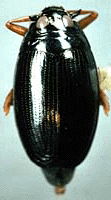
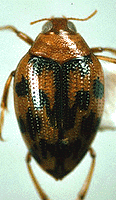
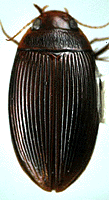
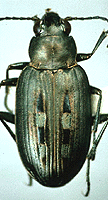
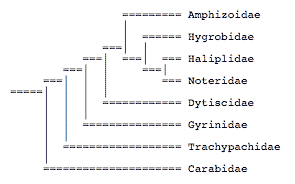







 Go to quick links
Go to quick search
Go to navigation for this section of the ToL site
Go to detailed links for the ToL site
Go to quick links
Go to quick search
Go to navigation for this section of the ToL site
Go to detailed links for the ToL site